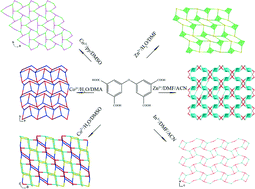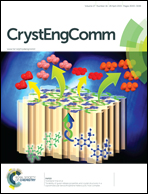Syntheses, topological structures and properties of six metal–organic frameworks constructed from a flexible tetracarboxylate ligand†
Abstract
Six new metal–organic frameworks (MOFs), Co2O(odip)(py)2(DMSO)2·3H2O (1), Co2(odip)(H2O)(DMA)2·2DMA (2), Co4(odip)2(H2O)4(DMSO)2·5DMSO (3), [Zn2(odip)(DMF)2(H2O)]·2DMF·2H2O (4), Zn2(odip)(H2O) (5) and In(odip)·3ACN (6), have been synthesized from the 5,5′-oxydiisophthalic acid (H4odip) ligand under solvothermal conditions. These six compounds were characterized by single-crystal X-ray diffraction, power X-ray diffraction and relative physical methods. MOFs 1, 2 and 3 are constructed from the same ligand and metal-salt under the same temperature, but with different solvents, and they exhibit three different topologies. MOF 1 possesses a 3D 4-coordinated architecture with a (65·8) topology. MOF 2 features a 3D 4-coordinated net with a (42·63·8) topology and MOF 3 shows a 3D 4-coordinated framework with a (4·64·8)(4·65) topology. MOFs 4 and 6 have the same topology as MOF 2. MOF 5 exhibits a 3D 5-coordinated framework with a (44·66) topology. These results indicate that the solvent environment plays an important role in the formation of the final framework. Moreover, the photoluminescence properties of 4 and 5, and the magnetic properties of 1, 2 and 3 have been studied and discussed.


 Please wait while we load your content...
Please wait while we load your content...